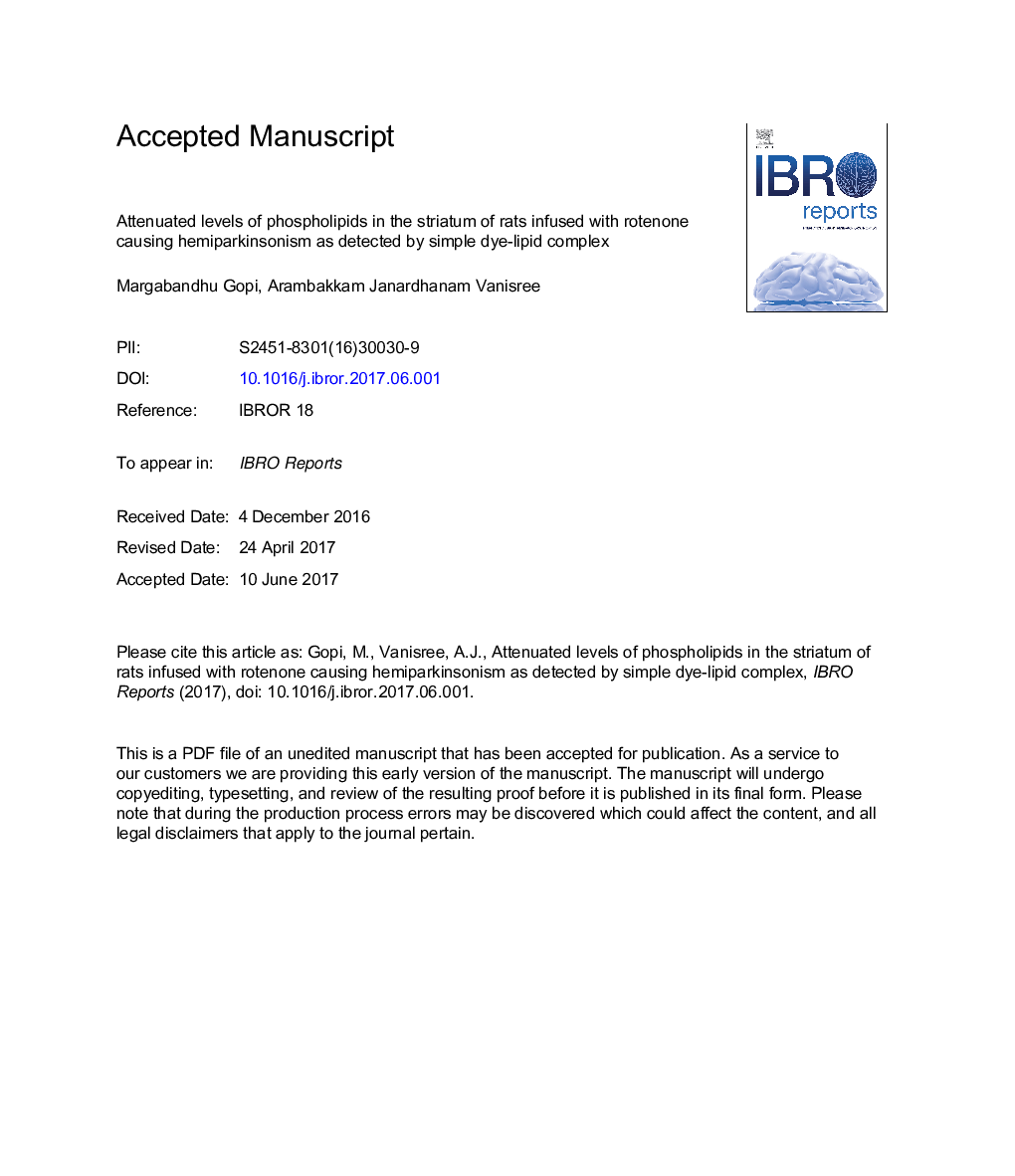| Article ID | Journal | Published Year | Pages | File Type |
|---|---|---|---|---|
| 5736420 | IBRO Reports | 2017 | 36 Pages |
Abstract
Parkinson's disease (PD), a progressive neurodegeneration, is characterized by loss of dopaminergic neurons in the substantia nigra (SN) and loss of motor co-ordination. Impaired metabolism of major lipids such as phospholipids which play regulatory roles in cellular functions and signaling has been implicated in the pathology of PD. We aim to investigate the striatal phospholipids (PLs) in hemiparkinsonism infused by rotenone in rats. As there are no cost-effective modes of PL, we have utilized dye-lipid complex technique for the first time in PD models for screening and also for semi-quantifying (individually) the levels of the deregulated PL in brain samples. Rats were divided into 2 groups: i. control and ii. ROT-infused which received intracranial injection of Rotenone (6 μg/μl; flow rate 0.2 μl/min). At the end of experimental period of 14 days, the striatum was dissected out for the analyses of PLs. Dye-based detection of PL and two-dimensional thin-layer chromatographic analyses of PL were performed. Detection of dye-PL complex was possible for phosphatidyl choline (PC), phosphatidyl inositol (PI), and spingomyelin (SM) (but not for phosphatidyl ethanolamine-PE) using dyes viz victoria blue B, toluidine blue and ammonium ferrothiocyanate, respectively. Two-dimensional analyses of phospholipids confirmed the dye-PL complex and depicted significant reduction (p < 0.05) on semi-quantitative assessment, in the striatum of control and hemiparkinsonic rats. We suggest a low level of PLs esp of PI in striatum of rats using a simple dye-detection that was validated by HR-LCMS. The finding implies that a critical role is being played by these PLs (PC, PI and SM) mainly PI (p < 0.001), in rotenone infused hemiparkinsonism, thus deserving wider but simpler investigations to detect and identify their role in parkinsonism.
Keywords
PtdIns5PMRMmultiple reaction monitorTLCTBAHSNeuromelaninNaClHClPLSPI(3,5)P2ESIDMSOPtdIns(3,4,5)P3PtdIns(4,5)P2SNpcStriatumhydrochloric acidTemAlzheimer's diseaseParkinson's diseasesubstantia nigra pars compactaDimethyl sulfoxideRotRotenoneSodium chlorideMass spectrometryphosphatidyl ethanolaminephosphatidyl cholinephosphatidylinositol 3,4,5-trisphosphatePhosphatidylinositol 3,5-bisphosphatephosphatidylinositol 4,5-bisphosphatePhosphatidylinositol 5-phosphatePhosphoinositidePhospholipidsAnsaTransmission electron microscopyDopaminergic neuronthin layer chromatographyelectrospray ionization
Related Topics
Life Sciences
Neuroscience
Cellular and Molecular Neuroscience
Authors
Margabandhu Gopi, Arambakkam Janardhanam Vanisree,
